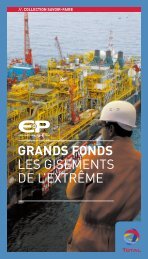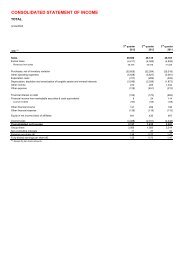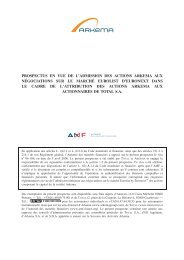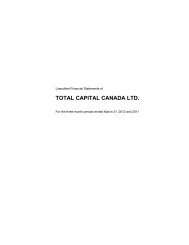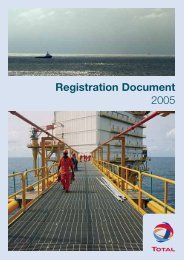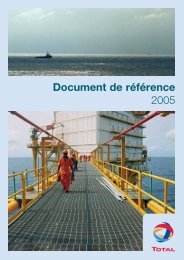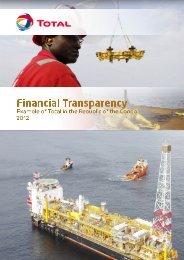Registration document 2007 - Total.com
Registration document 2007 - Total.com
Registration document 2007 - Total.com
Create successful ePaper yourself
Turn your PDF publications into a flip-book with our unique Google optimized e-Paper software.
29) Market risks<br />
Oil and gas market related risks<br />
Due to the nature of its business, the Group has a significant<br />
involvement in oil and gas trading as part of its normal operations<br />
in order to attempt to optimize revenues from its crude oil and<br />
gas production and obtain favorable pricing for supplies for its<br />
refineries.<br />
In its international oil trading activities, the Group follows a policy<br />
of not selling its future oil and gas production for future delivery.<br />
However, in connection with these trading activities, the Group,<br />
like most other oil <strong>com</strong>panies, uses energy derivative instruments<br />
to adjust its exposure to price fluctuations of crude oil, refined<br />
products, natural gas and electricity. Furthermore, the Group also<br />
uses freight-rate derivative contracts in its shipping activities in<br />
order to adjust its exposure to freight-rate fluctuations. In order to<br />
hedge against this risk, the Group uses various instruments such<br />
as futures, forwards, swaps and options on organized markets or<br />
over-the-counter markets.<br />
To measure market risks related to the prices of oil and gas<br />
products as well as the price of electricity, the Group uses a<br />
“value at risk” method. Under this method, for the Group's<br />
trading activities of crude oil, refined products and freight rate<br />
derivatives, there is a 97.5% probability that unfavorable daily<br />
market variations would result in a loss of less than 11.4 M€ per<br />
day, defined as the “value at risk”, based on positions as of<br />
December 31, 2006. Over the year 2006, the average value at<br />
risk was 8.6 M€, the lowest value at risk was 4.3 M€, the highest<br />
value at risk was 12.9 M€.<br />
As part of its gas and electricity trading activity, the Group also<br />
uses derivative instruments such as futures, forwards, swaps and<br />
options in both organized and over-the-counter markets. In<br />
general, the transactions are settled at maturity date through<br />
physical delivery. There is a 97.5% probability that unfavorable<br />
daily market variations would result in a loss of less than 6.0 M€<br />
per day, based on positions as of December 31, 2006. Over the<br />
year 2006, the average value at risk was 9.1 M€, the lowest<br />
value at risk was 3.5 M€, and the highest value at risk was<br />
21.7 M€.<br />
The Group has implemented strict policies and procedures to<br />
manage and monitor these market risks. Trading and financial<br />
controls are carried out separately and an integrated information<br />
system enables real-time monitoring of trading activities.<br />
Limits on trading positions are approved by the Group’s<br />
Executive Committee and are monitored daily. To increase<br />
flexibility and encourage liquidity, hedging operations are<br />
performed with numerous independent operators, including other<br />
oil <strong>com</strong>panies, major energy consumers and financial institutions.<br />
The Group has established limits for each counterpart, and<br />
outstanding amounts for each counterpart are monitored on a<br />
regular basis.<br />
Appendix 1 – Consolidated financial statements<br />
Notes to the consolidated financial statement<br />
9<br />
Financial markets related risks<br />
Within its financing and cash management activities, the Group<br />
uses derivative instruments in order to manage its exposure to<br />
changes in interest rates and foreign exchange rates. This<br />
includes mainly interest rates and currency swaps. The Group<br />
might also use on an occasional basis futures, caps, floors and<br />
options contracts. The current operations and their accounting<br />
treatment are detailed in notes 1 M, 20 and 27 to the<br />
consolidated financial statements.<br />
Risks relative to cash management activities and to interest rate<br />
and foreign exchange financial instruments are managed in<br />
accordance with rules set by the Group’s Management. Liquidity<br />
positions and the management of financial instruments are<br />
centralized in the Treasury Department.<br />
Cash management activities are organized into a specialized<br />
department for operations on financial markets. The Financial<br />
Control Department handles the daily monitoring of limits and<br />
positions and calculates results. It values financial instruments<br />
and, if necessary, performs sensitivity analysis.<br />
Management of currency exposure<br />
The Group seeks to minimize the currency exposure of each<br />
exposed entity by reference to its functional currency (primarily<br />
the euro, dollar, pound sterling, and Norwegian krone).<br />
For currency exposure generated by <strong>com</strong>mercial activity, the<br />
hedging of revenues and costs in foreign currencies is typically<br />
performed using currency operations on the spot market and in<br />
some cases on the forward market. The Group rarely hedges<br />
estimated flows and, in this case, may use options.<br />
With respect to currency exposure linked to non-current assets<br />
accounted in another currency than the euro, the Group has a<br />
hedging policy which results in reducing the associated currency<br />
exposure by financing in the same currency.<br />
Short-term net currency exposure is periodically monitored with<br />
limits set by the Group’s executive management. The Group’s<br />
central treasury entities manage this currency exposure and<br />
centralizes borrowing activities on the financial markets (the<br />
proceeds of which are then loaned to the borrowing subsidiaries),<br />
cash centralization for the Group <strong>com</strong>panies and investments of<br />
these funds on the monetary markets.<br />
Management of short-term interest rate exposure and<br />
cash<br />
Cash balances, which are primarily <strong>com</strong>posed of euros and<br />
dollars, are managed with three main objectives set out by<br />
management (to maintain maximum liquidity, to optimize revenue<br />
from investments considering existing interest rate yield curves,<br />
and to minimize the cost of borrowing), over a horizon of less<br />
than twelve months and on the basis of a daily interest rate<br />
TOTAL – <strong>Registration</strong> Document 2006 227




